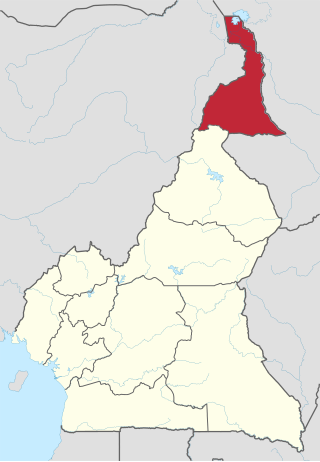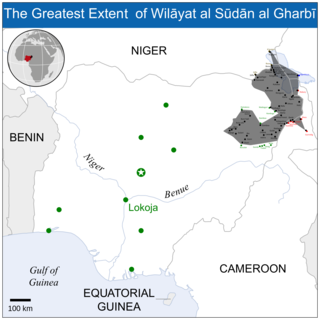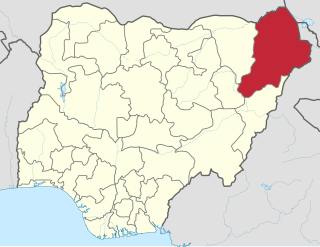
The Far North Region, also known as the Extreme North Region, is the northernmost constituent province of the Republic of Cameroon. It borders the North Region to the south, Chad to the east, and Nigeria to the west. The capital is Maroua.

Boko Haram, officially known as Jamā'at Ahl as-Sunnah lid-Da'wah wa'l-Jihād, is an Islamic terrorist organization based in northeastern Nigeria, which is also active in Chad, Niger, northern Cameroon, and Mali. In 2016, the group split, resulting in the emergence of a hostile faction known as the Islamic State's West Africa Province.
Abadam is a remote Local Government Area of Borno State, Nigeria, on the western coast of Lake Chad. It borders Chad and Niger, and it's very close to Cameroon, in 2016 its population is projected to be 140,000 inhabitants, It has its headquarters in the town of Malumfatori. Security, Healthcare, infrastructure, and climate change are some of the major challenges in Abadam Local government.
Marte is a Local Government Area of Borno State, Nigeria, on the western coast of Lake Chad. Its headquarters are in the town of Marte
Kolofata is a town and commune in Cameroon.
The A3 highway is a highway in Nigeria. It runs generally north from Port Harcourt through Aba, Umuahia, Okigwe, Enugu, Ngwo, Makurdi, Lafia, Jos, Bauchi and Potiskum thence east via Damaturu and Maiduguri to the border with Cameroon at Gamboru. The 50-kilometre (31 mi) continuation through Cameroon connects to N'Djamena, the capital of Chad.

The Boko Haram insurgency began in July 2009, when the militant Islamist and jihadist rebel group Boko Haram started an armed rebellion against the government of Nigeria. The conflict is taking place within the context of long-standing issues of religious violence between Nigeria's Muslim and Christian communities, and the insurgents' ultimate aim is to establish an Islamic state in the region.
Timeline of the Boko Haram insurgency is the chronology of the Boko Haram insurgency, an ongoing armed conflict between Nigerian Islamist group Boko Haram and the Nigerian government. Boko Haram have carried out many attacks against the military, police and civilians since 2009, mostly in Nigeria. The low-intensity conflict is centred on Borno State. It peaked in the mid 2010s, when Boko Haram extended their insurgency into Cameroon, Chad and Niger.
The Konduga massacre took place in Konduga, Borno State, Nigeria on 11 February 2014. The massacre was conducted by Boko Haram Islamists against Christian villagers. At least 62 people were killed.
On the night of 5-6 May 2014, Boko Haram militants attacked the twin towns of Gamboru and Ngala in Borno State, northeastern Nigeria. About 310 residents were killed in the 12-hour massacre, and the town was largely destroyed.
Gamboru is a market town in Borno State, northeast Nigeria, near the Cameroon border. It is the administrative centre of Ngala local government area.
As of 31 August 2020, Cameroon hosted a total refugee population of approximately 421,700. Of these, 280,500 were from the Central African Republic, driven by war and insecurity. In the Far North Region, Cameroon hosts 114,300 Nigerian refugees, with the population sharing their already scarce resources with the refugees.
The following lists events from 2014 in Nigeria.
The following lists events that happened during 2015 in Chad.

Starting in late January 2015, a coalition of West African troops launched an offensive against the Boko Haram insurgents in Nigeria.
On three days immediately before and during Ramadan, 2015, four attacks struck Chad's capital N'Djamena. Three suicide attacks against two police targets killed 33 people on 15 June, five policemen and six terrorists were killed during a police raid on 27 Jun, and a suicide bomber killed 15 in N'Djamena's main market, on 11 July.
The 2015 Fotokol attack occurred on 4 and 5 February 2015 when Boko Haram militants reportedly killed at least 91 people by shooting and burning, and injured over 500 in Fotokol, Cameroon. The militants, who are based in northeastern Nigeria and active in Chad, Niger and northern Cameroon, also torched mosques and churches of the town. This attack came a day after the regional forces said it had driven Boko Haram from Gambaru, a Nigerian town close by. This was the second foreign country attack by the militants in 2015. This region of Niger is an area where refugees had arrived by the thousands seeking safety from Boko Haram attacks.
The 2015 Chad suicide bombings were a suicide attack which occurred the afternoon of Saturday 10, October 2015 in the town of Baga Sola, Chad, a small fishing community on Lake Chad. The attack was allegedly perpetrated by the Nigeria-based Islamic extremist group Boko Haram and resulted in the deaths of around 36 individuals, and wounded upwards of 50 more. The attacks were reportedly carried out by two women, two children, and a man with the intended targets being a busy marketplace, and a nearby refugee camp hosting tens of thousands of Nigerians. It was the deadliest attack to take place in the Lake Chad region.

The Chad Basin campaign of 2018–2020 was a series of battles and offensives in the southern Chad Basin, particularly northeastern Nigeria, which took place amid the ongoing Boko Haram insurgency. The Chad Basin witnessed an upsurge of insurgent activity from early November 2018, as rebels belonging to the Islamic State's West Africa Province (ISWAP) and Boko Haram launched offensives and several raids to regain military strength and seize territory in a renewed attempt to establish an Islamic state in the region. These attacks, especially those by ISWAP, met with considerable success and resulted in the displacement of hundreds of thousands of civilians. The member states of the Multinational Joint Task Force (MJTF), namely Nigeria, Niger, Chad, and Cameroon responded to the increased insurgent activity with counter-offensives. These operations repulsed the rebels in many areas, but failed to fully contain the insurgency.

At about 5pm on 6 January 2020, a bomb exploded at a market in Gamboru, Borno State, northeastern Nigeria. The market is located on a bridge which connects Gamboru to Fotokol, Logone-et-Chari, Far North Region, Cameroon. The bombing killed 38 people and injured over 35 others. No group claimed responsibility. Boko Haram often carry out attacks in the region, their insurgency having caused over 35,000 deaths since it began in 2009.






